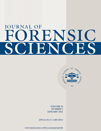Sex Determination Using the Second Cervical Vertebra—A Test of the Method*
Presented as a poster at the 76th American Association of Physical Anthropology Conference, March 28–31, 2007, in Philadelphia, PA.
Abstract
Abstract: Sex is one of the critical questions addressed when unidentified skeletal remains are discovered in forensic or archeological contexts. Continuous testing and re-evaluation of existing techniques is essential to improve accuracy and precision. The Wescott (J Forensic Sci 2000;45(2):462–6) method of sex determination from dimensions of the second cervical vertebra was blind-tested on 153 adult individuals from the Spitalfields documented collection of human skeletal remains held at the Natural History Museum, London. Significant sex differences were determined for all dimensions measured (independent two-sample t-test, p < 0.05–0.001). The discriminant functions developed by Wescott were shown to have an overall accuracy of classification of 76.99%. Using stepwise discriminant analysis, a discriminant function based on the Spitalfields data correctly classified sex in 83.3% of individuals and was able to classify males and females with equal accuracy. Additional discriminant functions are presented for use in instances where preservation of the second cervical vertebra is poor.




